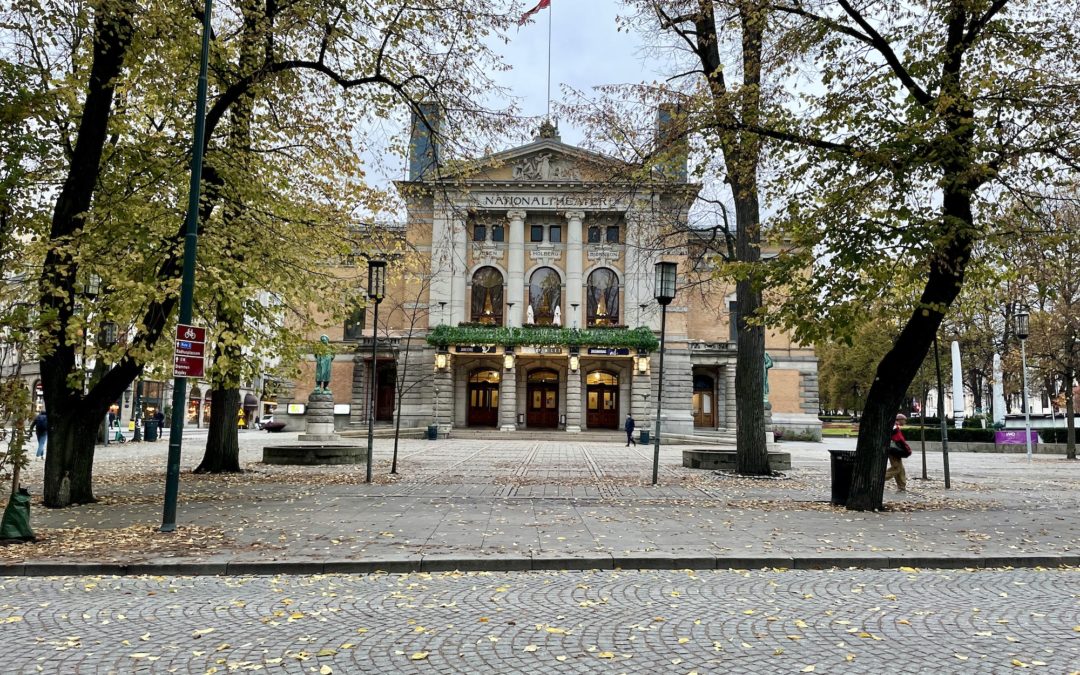
by SylviaItaly | Oct 24, 2022 | Running
Oslo is the capital of Norway and the country’s biggest city. It has a population around 700.000 inhabitants.
Last week I visited Oslo. I was there on a business trip. This was my first time in that city.
Scandinavian countries have always been unknown for me due to my life and situation in Italy. Now that I am back in Rotterdam I do lots of different work in the wine and running industry. In the Netherlands as well as abroad.

October is the ideal time of the year to enjoy the wonderful fall scenery in Oslo. It can be pretty cold but I had some gorgeous sunny days.
It’s time to celebrate the good life. Cheers!
Locals
The people are all friendly and welcoming to everyone. They are polite and speak English very well. I don’t speak Norwegian, some words sound much the same as Dutch but written a little differently. It is a Germanic language like German, English and Dutch.
For instance “damer” means dames (ladies) in Dutch, “danse” is dansen (dancing) and “du er min beste venn” says “je bent mijn beste vriend” (you are my best friend).
Just to mention a few examples of the Norwegian language.

The Royal Palace
Travel
The city is easy to travel thanks to Oslo’s public transportation system. It is pretty hard to get lost because everything is very simple to find.
And if you don’t prefer using the bus or tram, you can walk, run or bike like many locals do 🙂
Running in Oslo
Oslo is one of the most walkable -running- capitals of the world. It has many pedestrian-friendly areas.

Vigeland Park
I brought my running shoes and running gear with me to Oslo. In addition to working at the wine tasting event I wanted to discover the city as good as possible. My schedule was quite busy, so running early in the morning was my best option to explore new things.
I noticed that many people in Oslo enjoy their morning run. They love getting up early like me. Personally I don’t like to run full speed when I go outside on the streets. For me it’s important to learn about the place and appreciate the surroundings.

Vigeland Park
Running around helps me to build a better image of the city I am visiting. I can recommend it to everyone who loves running. Not only because you see more hidden gems, you feel great and energetic after the run. You’re motivated to start a new day!
Vigeland Park
Oslo has great places to spot. In the centre you find great museums, beautiful parks, modern architecture, historical buildings, galleries, harbor promenade, nice coffee bars and good restaurants.

Pastis Bistrobar
I have discovered different running routes in the city centre of Oslo. It is a wonderful green city where you can run every day.

Vigeland Park
The wonderful Vigeland Park in the city Oslo is a top tourist attraction. Vigeland Park is within Frogner Park. It is a large sculpture park by a single artist “Gustav Vigeland”.
The sculptures in bronze, granite and iron represent the cycle of human life and all its emotions. Really worth visiting!

Vigeland Park

Vigeland Park

Harbour promenade Oslo
Oslo Opera House
Also walking up the roof of the Oslo Opera House provides wonderful views over the harbour and the city.

Opera House

Oslo city
Enjoy your run in Oslo! And see you soon again, you’re wonderful.

Running routes by Sylvia
Running route 1 Wednesday October 19, 2022

Vigeland Park
Running route 2 Thursday October 20, 2022

Running route 3 Friday October 21, 2022


by SylviaItaly | May 24, 2022 | Wine tasting
Prowein in Düsseldorf is a hot spot full of “wine” inspiration. It is one of the most important wine and spirits fair in Central Europe. Prowein always takes place on 3 days from Sunday till Tuesday.
After two years of cancellation in 2020 and 2021 due to the COVID pandemic, ProWein returned to Düsseldorf on 15-17 May, 2022.
This year I have decided to visit the international wine fair again. I only had one day of the fair to spend. It was an intense day and perhaps not enough to do everything, but I enjoyed it very much.
Personally, Prowein gives me the opportunity to discover different wines and wineries of the world. For me, tasting as much as possible is fun and it the best way to learn about wines.
I started tasting wines from Trentino and I ended up with Tempranillo and Verdejo wines from Casilla y Léon. I cannot remember exactly how much different wines I have tasted but the ones I remember were wines from the New World, Italy, Spain, Portugal and France.
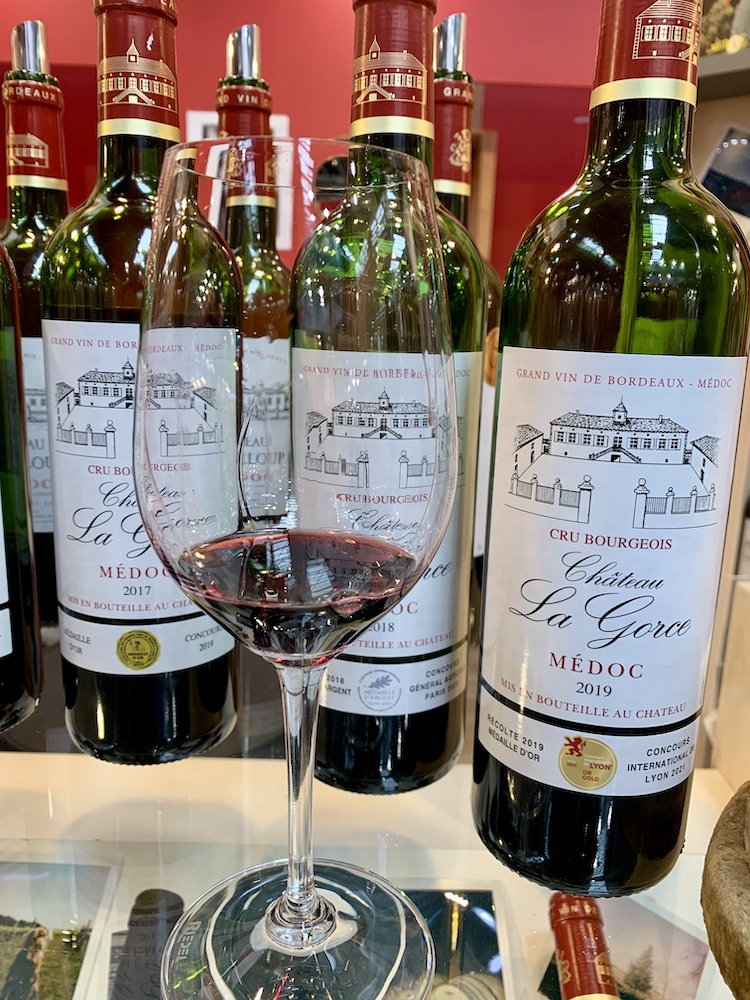

Powerful dry wines with high tannin levels, high alcohol and fruit concentration such as Barolo and Médoc were one of my favorites!
And here are some of my favorite images I took while visiting ProWein:


Outstanding wines from Chilean Cabernet Sauvignons.


Interesting to try different California Chardonnay’s aged with oak chips in stainless steel. One Chardonnay tasted different from the next. From apples, lemons to something sweeter.

Having the opportunity to taste many Champagnes is amazing. Vintage Champagne Blanc de Blancs 2006. A Champagne only made from Chardonnay grapes. Cheers!

Sicilian wines! Grillo is a widely planted Sicilian white grape. The grape is well suited to hot and dry climates. Grillo is used commonly in a variety of still white wines.
The Nero d’Avola instead is a renowned indigenous red grape variety in Sicily. The grape is also known as “Calabrese”. This grape loves heat as well, just like the Grillo. The wine has character. It is a strong and medium to full bodied red wine.

Wines from the PIWI grape varieties. Ever heard of it? I didn’t, until I met Enrico from Cantina Terre di Ger in Friuli Venezia Giulia, Italy. PIWI grapes are fungal resistant. The wines taste good or even excellent.

The Verdejo wines from Rueda in the Castilla Y León region (Spain) are popular white wines around the world. I explored some nice wines from an organic and unique bodega.

The atmosphere at ProWein is welcoming, personable and educative. It is a great opportunity to meet new people and to talk about wine and business.
See you next year!

by SylviaItaly | Feb 20, 2022 | Italian wines, Italy, Tuscany
We are at the end of the online course DipWSET4 – D1.
Uffa..

It were intense weeks with lots of posts, research, questions, wine tastings and group activities.
Many projects required a lot of effort!

In the first week of our course we needed to work alone on our vineyard establishment proposal. I choose for the wine area Bolgheri in Tuscany. This is my proposal I have submitted in the first week of our wine course.
Happy reading!
Bolgheri
I choose the territory of Bolgheri (Livorno) along the Etruscan coast, at the foot of the gentle Tuscan hills and a few miles from the sea.

The climate along the coast in Tuscany is more maritime than central Tuscany. The summers are dry, sunny and breezy. The weather is influenced by the sea. Temperatures in winter time are around 8-10 degrees, and reach rarely zero or less.
The sea and Apennine mountains moderate the temperatures in summer period. The driest months in Tuscany are July and August.
Bolgheri Rosso DOC
Bolgheri Rosso DOC is a blend of black grape varieties. The red wine can be made in different styles. I will plant the following grapes: Cabernet Sauvignon, Merlot, Syrah and Sangiovese.

The black grape varieties need sunlight and heat to ripen fully. The grapes do not ripen at the same time. Merlot ripens earlier than Cabernet Sauvignon and Sangiovese for instance. The harvest of the grapes is spread out.

Vine training system black grape varieties: cane pruned (single guyot), cordon trained. The vine’s cane and shoots are tied to the trellis for light and air circulation. Summer pruning will hardly take place as the leaves protect the berries from sunburn in (warm) summer conditions.
The soil is calcareous and contains a mix of rocks. There is a good drainage, which is important for grape growing. The altitude of the vineyards are about 100 – 400 m above sea level and the slopes are facing southwest.
The wine is full bodied with ripe red and black fruits, medium-high tannin, high acidity and high alcohol. Long aftertaste.
Suited for aging.

Super Tuscan wines have gained popularity in Italy and abroad since the 20th century. Especially the red wines. The wines are prestigious and sometimes also very expensive.
The average price for this wine is Euro 25.00*.
*average price of Sylvia Italy’s Rosso wine – not available in my shop.
Bolgheri Rosato DOC
The black grape varieties used for the rosé are Syrah, Merlot and Sangiovese. This wine is a blend and pairs good with fish dishes. For example with the local cacciucco from Livorno.
Bolgheri Bianco DOC
For a white wine from the region I will plant Vermentino grapes. Vermentino is often vinified as a single variety but can also be blended with other white grape varieties such as Trebbiano Toscano.

The vine training system for the Vermentino grapes are cane pruned (guyot). The sea has a positive influence and gives Vermentino a mineral and aromatic character.
The Vermentino wine is an appetizer wine and pairs excellent with local fish dishes.

For both young wines the average price per bottle is Euro 13.00-15.00*.
*average price of Sylvia Italy’s Bianco wine – not available in my shop.
Super Tuscan wines are produced also in other places in Tuscany, but Bolgheri is the birthplace of this wonderful wine.
Alla salute!

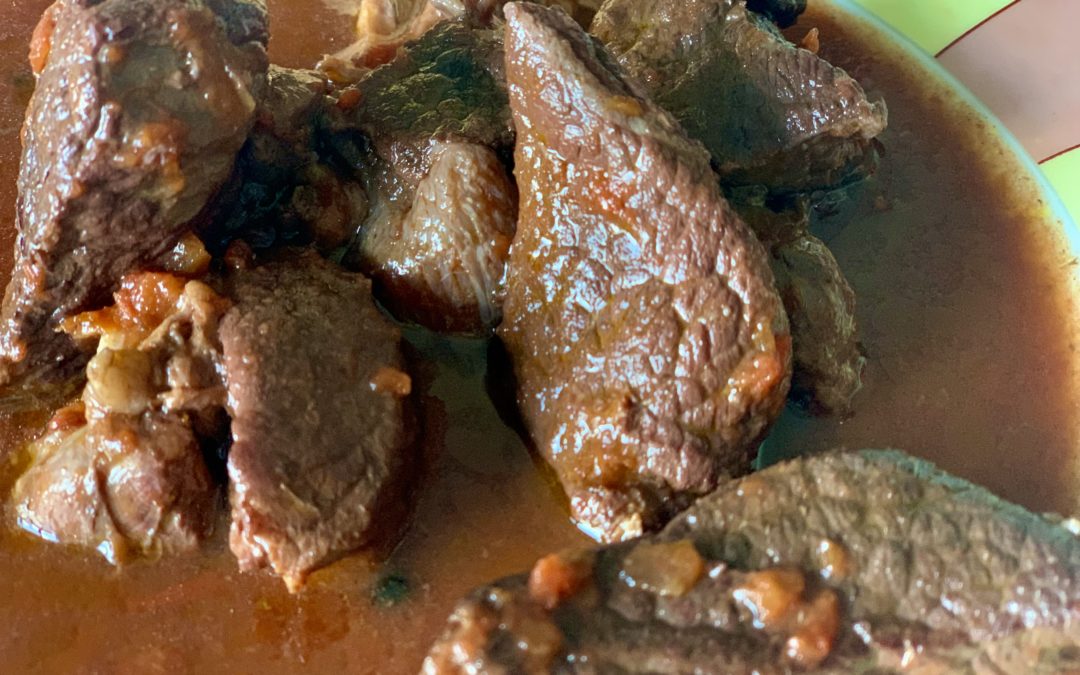
by SylviaItaly | Feb 13, 2022 | Food, Italy, Recipes, Tuscany
Peposo is a traditional Tuscan pepper beef stew. It is one of my favorite Italian dishes.
I know, I have many favourite dishes, but my peposo recipe brings you right away to Florence!

Peposo is rich in flavour. It really has a delicious spicy kick from the black pepper, hence the name “peposo”.
This -500 years- old dish is easy to make. Peposo is still popular across Tuscany. It originally comes from the village Impruneta, a small town in the Tuscan hills. The former name of the recipe is “Peposo alla Fornacina”, but today it is called “Peposo”.
Recipe peposo
Sylvia Italy’s peposo is made with beef chuck for stew, NO garlic*, whole black pepper corns, black powder pepper, salt, olive oil, tomato sauce to give the sauce a bit body, and red Tuscan wine: Rosso di Montepulciano DOC.
That’s it!

*Peposo without garlic tastes equally good. I eat onions and garlic, but sometimes I prefer avoiding it. I don’t like the bad breath and lingering aftertaste in my mouth.
Ingredients:
Serves 2 people
- 300 g boneless beef chuck for stew
- a handful of black pepper corns
- black pepper powder
- salt
- 1/4 liter of red wine (Chianti or Rosso di Montepulciano)
- tomato sauce*
*The original recipe peposo is more likely not to be made with tomato sauce.


Preparation
For gentle cooking, like stews, I always use my cast Creuset iron pot.

Heat the olive oil in a pot over a medium-high heat and brown the beef for a minute of 3. Add the red wine, salt, pepper and the tomato sauce.

Cover the pot, lower the heat and cook the peposo for approximately 3 hours. Check it often and give it a stir occasionally. It is important that the meat remains covered in wine and adding water if necessary.
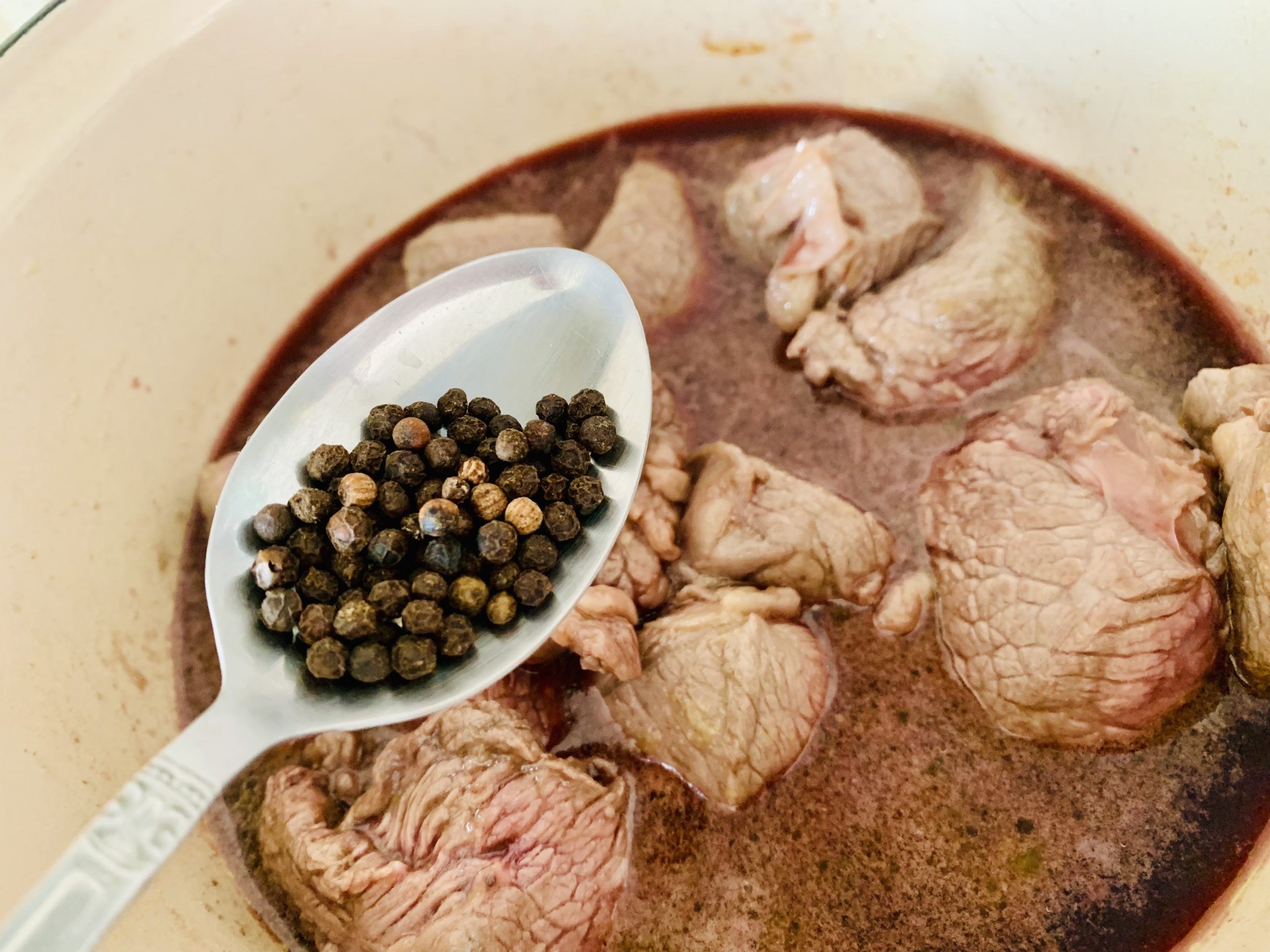


It says that cooking longer than needed doesn’t mean tender meat, but personally I prefer cooking it long.
When the peposo is ready, the meat should be tender (I love it when the meat is falling apart..yummy) and the red wine should have reduced to a sauce.
Season with more pepper if desired and serve warm on traditionally sliced bread (preferably Tuscan bread without salt) or polenta.
Buon appetito!

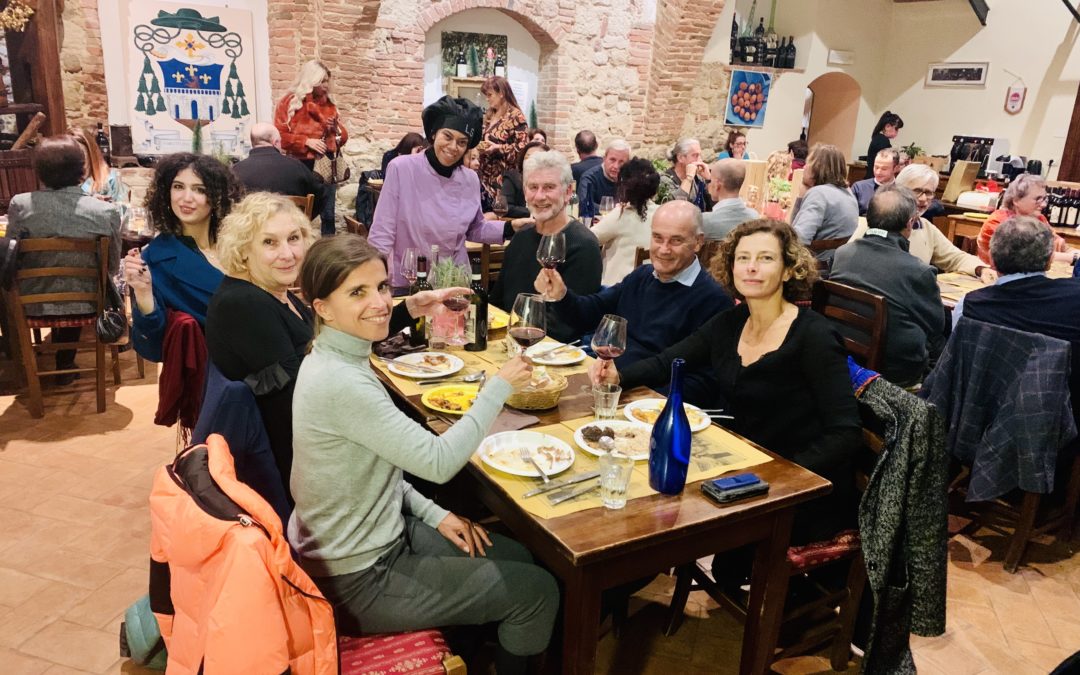
by SylviaItaly | Jan 15, 2022 | Food, Italy, Tuscany
Cantina Gattavecchi organizes a yearly fundraising dinner for the Breast Cancer Foundation “Io Sempre Donna“. Io Sempre Donna is in Chianciano Terme, a small village nearby Montepulciano.
Usually this annual charity dinner offers food from all over the world. But this time chef Lilian Gattavecchi decided to offer an Italian night with food from different regions, such as: Trentino – Alto Adige, Veneto, Calabria, Sardegna, Liguria, Toscana, Piemonte, Sicilia and Lombardia.
The wines they served were local wines from winery Gattavecchi: Toscana IGT red and white; Rosso di Montepulciano DOC; Vino Nobile di Montepulciano DOCG and Vino Santo di Montepulciano DOC.
The total amount of the dinner was euro 30.00 per person (including bread, water and wine).
Io Sempre Donna
Breast cancer is the second most common cancer among women. Io Sempre Donna helps women who are dealing with breast cancer and are in need of emotional support.
In Italy women who are 50 years or older (until 69) have screenings every 2 years. Women with a family history of breast cancer have a routine screening mammograms every year.
Io Sempre Donna means literally “Me always a woman”. Women diagnosed with breast cancer face a difficult time. Io Sempre Donna assist and support them before, during and after hard times.
Menu charity dinner
Antipasti
Toscana – nero toscano (chicken liver)
Calabria – BOMBA calabra (chilly peppers)
Umbria – salame al tartufo e crostini funghi mozzarella
Sardegna – pecorino cheese
Veneto – baccalà mantecato (stockfish)

Primi piatti
Trentino Alto Adige – canederli in brodo
Campania – scialatelli alla sorrentina
Piemonte – la paniscia alla novarese



Secondo piatti
Lombardia – polenta con le quaglie (quail)
Toscana – peposo (red wine beef stew with lots of pepper)


Contorni
Liguria – patate al forno con i funghi
Sicilia – melanzane (eggplants)
Toscana – fagioli bianchi (white beans)

Dolci
Toscana – crostata / biscotti al Vino Nobile
Lombardia – tiramisù

Conclusion
The food was fabulous. We were a bit too full at the end but it was really amazing. A great experience!































































